For people outside India, the ancient Indian forts may seem like mere walls, bricks, and ruins. But only we know that these fortifications are the best testaments to our culture, heritage, and political history. The ancient warriors clubbed the intelligence of the human mind with the stealthy might of the forts to bring brilliant triumphs to the homeland. Kalinjar Fort is one of the many breathtaking forts in the country and is known for its stunning architecture.
Kalinjar Fort is more than a relic or a construction from the bygone era. It has endured wars, stopped invasions, and protected the people of the country. It won’t be wrong to say that the Kalinjar fort is the guardian of our history and every stone here has a tale to tell.
If you are planning to visit the Kalinjar Fort soon, we have all the deets you need to know to appreciate the place better. Read on to find out more about this astonishing structure whose origins are still shrouded in mystery.
You May Also Like To Read: TOP 10 BREATHTAKING PALACES AND FORTS OF INDIA THAT YOU SHOULD NOT MISS
Where is Kalinjar Fort?
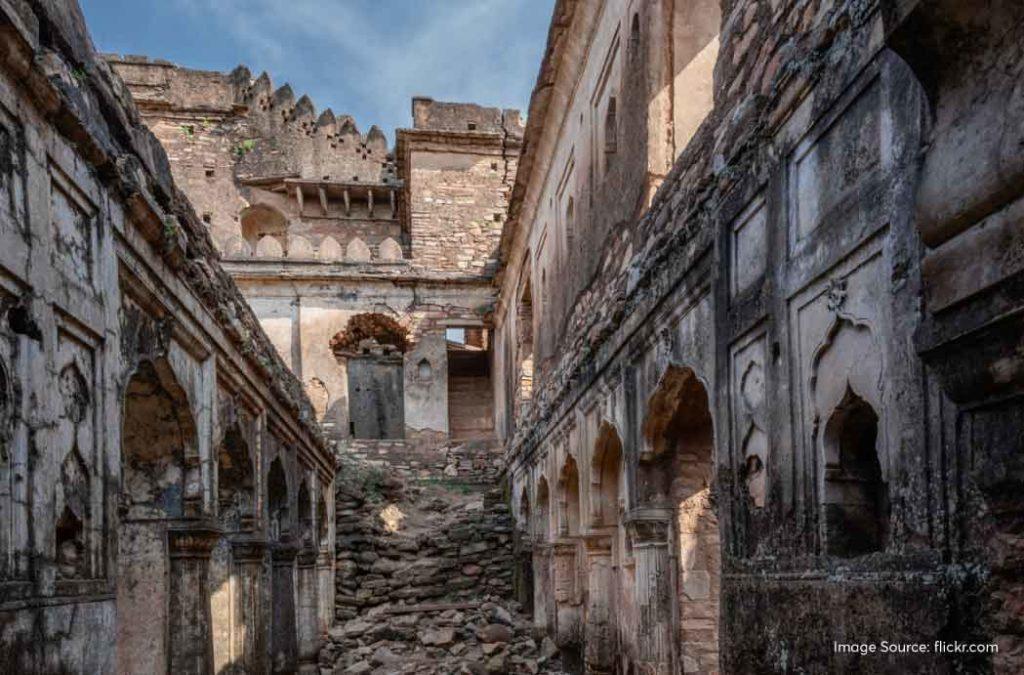
Kalinjar Fort is present in the Tarahati village of Bandra district in Uttar Pradesh. The entire region where the fort is present is also referred to as the Kalinjar village, named after the fortification. It is hard to miss the magnificent construction when you reach the area. It stands mighty tall on an isolated hill at the extreme end of the Vindhya mountain range. Once you climb up to the highest point in the fort, you can see the entire region of Bundelkhand, one of the most important administrative regions during the rule of the Rajputs.
It is said that the Kalinjar fort was built sometime during the 3rd to 5th centuries but no one is sure about its origins. It is possible to get a 360-degree view of the surrounding areas from the Kalinjar Fort, so it is quite evident why this place served as an important advantage for the ruling king’s soldiers.
Mention in the Hindu Mythology
Samudra Manthan is a very important event that was narrated in the Vishnu Purana. After the deities lost all their powers because of the disrespect Lord Indra’s mount, Airavata, caused sage Durvasa, the celestial beings were paranoid. The asuras or demons, led by Bali, won the war and took over the three worlds – earth, ocean, and the skies. The deities asked the help of Lord Vishnu and he suggested they approach the issue diplomatically. With no powers, fighting a war will only invite doom.
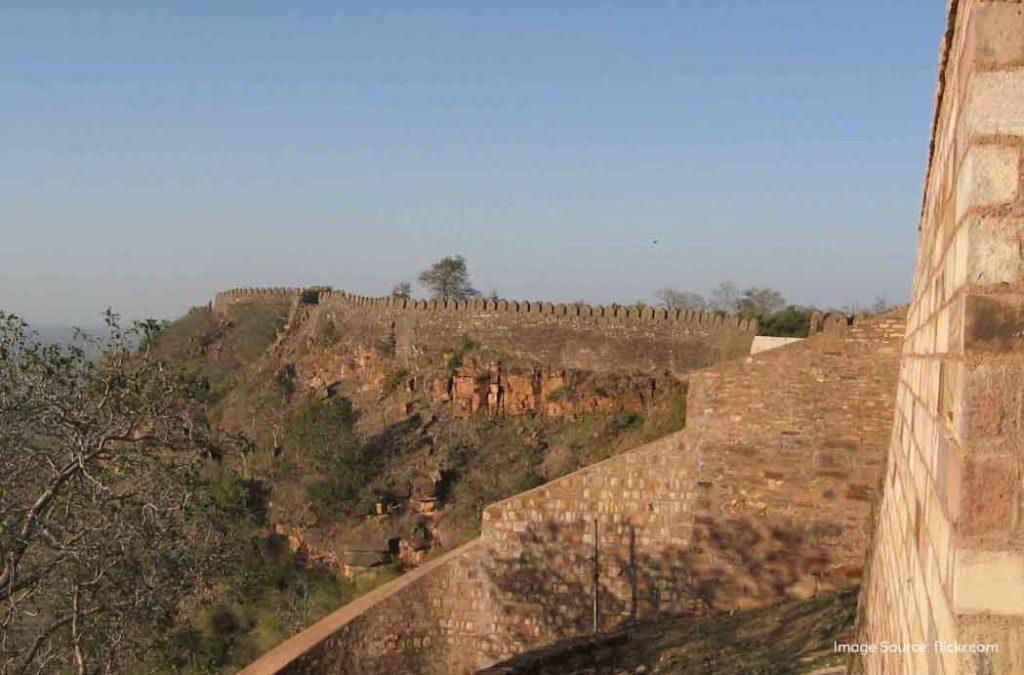
The deities and demons decided to engage in Samudra Manthan or the churning of the ocean. The agreement was that the winner of Samudra Manthan would get to consume the eternal elixir, Amrit, that would emerge during the churning.
When the deities and demons began churning the ocean, they noticed that a blue poison emerged before the ‘Amrit’ could. They couldn’t stop the Manthan but also had to escape the ill effects of the dangerous liquid. It was then that Lord Shiva appeared and consumed the poison. He stopped the poison from entering his gut and stored it in his throat. His neck immediately started turning blue and that earned him the name of Neelkanth or the one with the blue neck.
It is said that Lord Shiva came to the Kalinjar Fort and this was where he defeated death. The poison no longer troubled him and the fort became an auspicious place. Kalinjar literally translates to the ‘defeat of death’ – kaal meaning ‘time or death’ and jar meaning ‘defeat’. Seeing how the fort proved to be a defence advantage, we can say that it defeated death several times to save kingdoms, kings, and their armies.
History of Kalinjar Fort
Many kings ruled the region where Kalinjar Fort is present. The prominent dynasties include the Guptas, the Vardhanas, the Rewa, the Mughals, the Marathas, and finally the British. However, the Chandelas are the ones who are often remembered for their rule over the Kalinjar Fort.
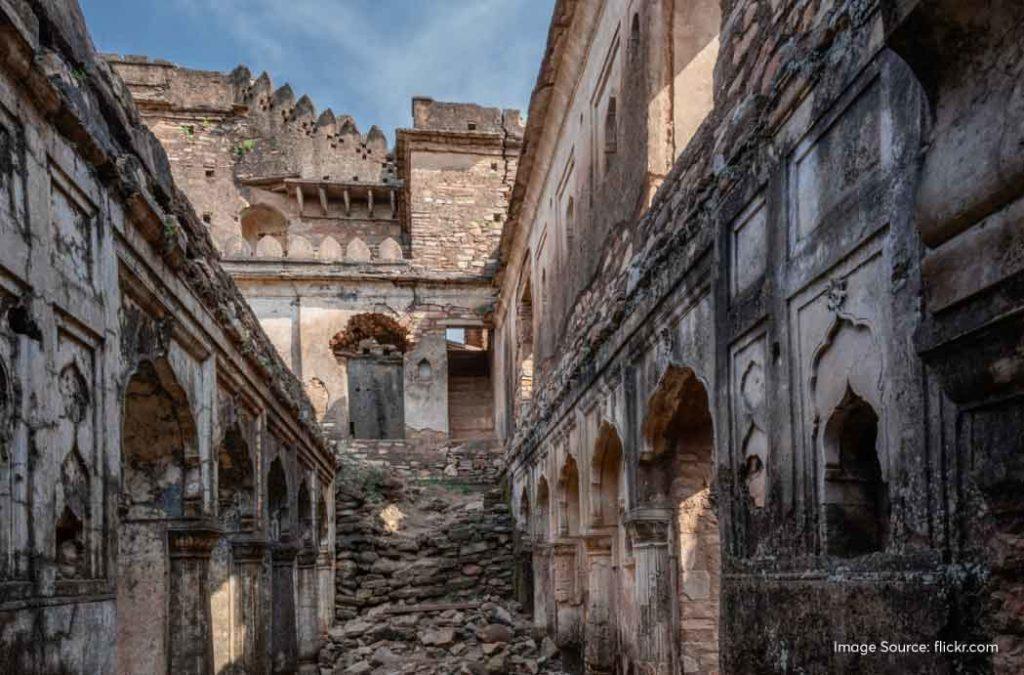
The Chandelas ruled during the 9th to 13th Century. The kings of this dynasty were also famously referred to as ‘Kalanjaradipati’ or the ‘Lord of Kalinjar’. This fort was successful in keeping Mahmud of Ghazni out of the kingdom during the 11th century, that too twice! Even Qutubbudhin Aibek, the general of Muhammed Ghori, couldn’t capture the fort or the kingdom it protects. Eventually, the fort came under the rule of the Mughals and in the time of Akbar, it was gifted to his favourite Navratans, Raja Birbal. After Aurangzeb, the fort came under the control of King Chhatrasal of Bundelkhand. It was in 1812 CE that the fort became a part of British jurisdiction.
The Kalinjar Fort never failed its rulers, as if it indeed fought with death to save the people who relied on it. The Britishers were not as generous to the fort as our ancestors had been. They did not understand the spiritual significance or the importance of the structure. That is why, in 1866, they destroyed a part of the fort which remains in ruins.
Main Attractions and Architecture of Kalinjar Fort
One of the best parts about the Kalinjar Fort is that a large part of the fort is concealed by the dense forest. The intruders or attackers cannot get a full view of the place because of the green cover. The outer rampart of the fort is about 45 metres tall and any cannonball thrown at the fort would bounce back to return toward the attackers. Sher Shah Suri experienced this first-hand when his cannonball bounced back and landed on his stack of explosives. He had to sustain multiple third-degree burns that eventually led to his death!
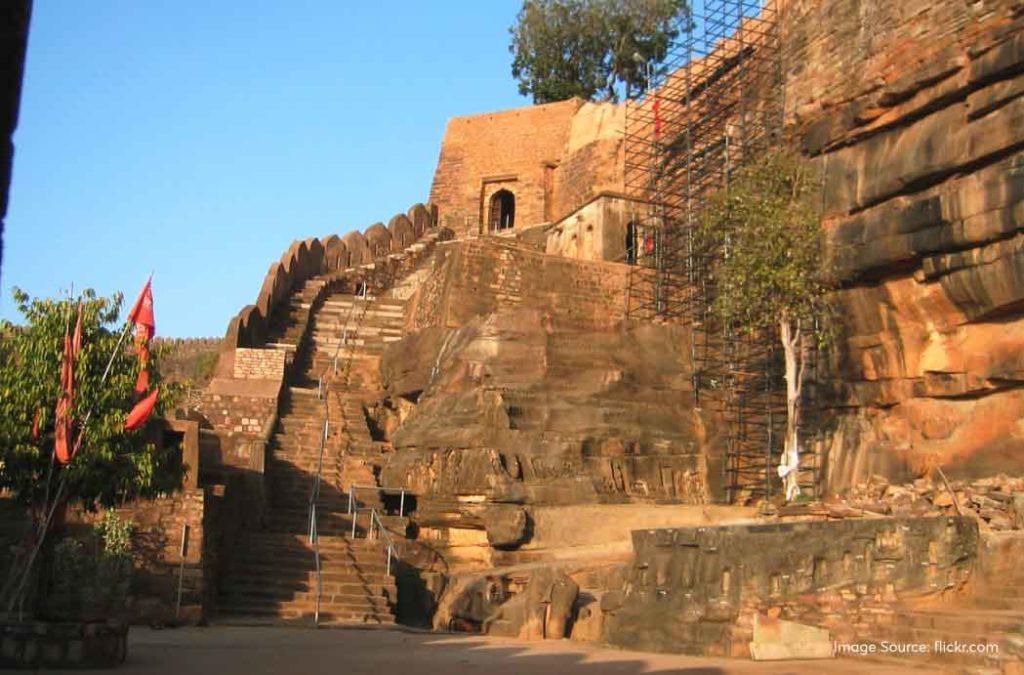
There are six entrances to the fort, namely, the Alamgiri Gate, the Ganesh Gate, the Chandi Gate, the Hanuman Gate, the Buddhabadra Gate, Laal Darwaza, and Bada Darwaza. The bastions offered a perfect view of the enemy and also served as the right spots for launching our attack. These bastions also had religious significance and were named after Hindu Gods. They include the Neelkant Mahadev Bastion, the Ganesha Bastion, and the Hanuman Bastion.
The fort also houses mosques, temples, palaces, and stepwells. Some of the palaces are in total ruins while the others still show us a glimpse of the Mughal’s regal era. You will be surprised to see that the tanks and water storage systems here are so well-developed for the time. There are several artillery and military installations, and places to keep the weapons, and all of these sites have beautiful intricate carvings that depict Indian culture. You will also find Sher Shah Suri’s tomb in the fort premises.
Neelkant Temple in Kalinjar Fort
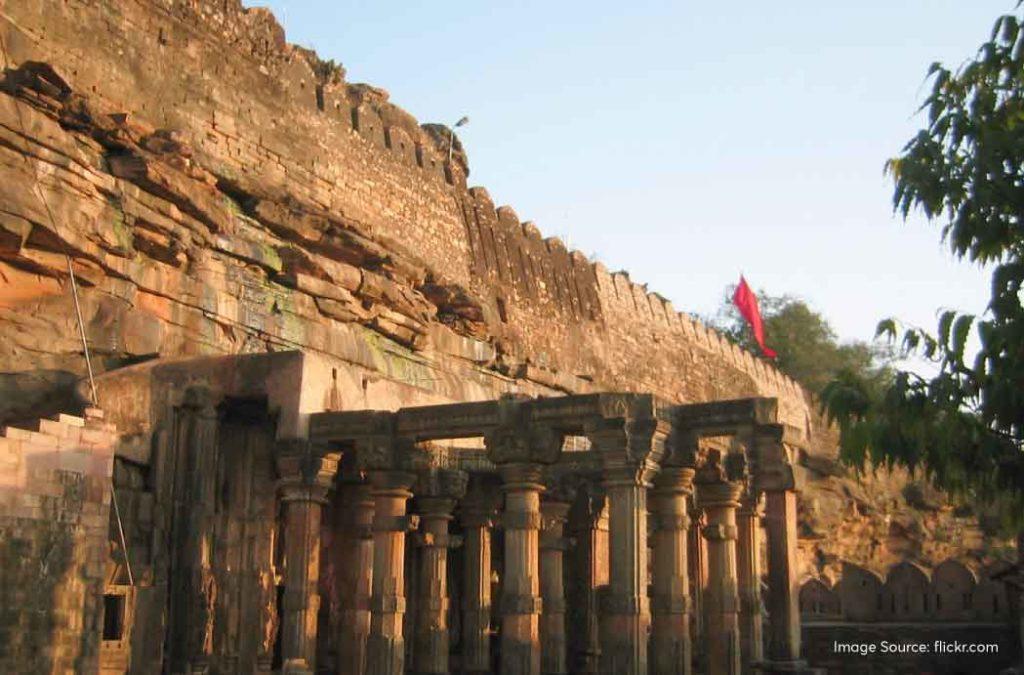
The Neelkant temple is the main attraction in the Kalinjar Fort. As Lord Shiva defeated death on this very same land, the temple was built to hail his supremacy. Inside the shrine, you will see Lord Shiva in the ‘Neelkant’ form – serene and tranquil. Outside, there is a huge sculpture of Kaal Bhairav. He is believed to be the most fierce form of the God whose body is jet black which signifies anger. Kaal Bhairav is the ferocious form of the deity that can defeat death and conquer time in a snap. The intricate artwork has 18 arms and a garland made of skulls around the neck.
Adjacent to the Kalinjar fort, there is a pond that is believed to have miraculous healing powers. Even the King of Chandela, Kirti Singh, who suffered from a skin ailment was able to cure his illness by taking a dip in the waters. It is also said that taking ‘three’ dips in the pond can give you the merit of donating a thousand cows. Among Hindus, donating a cow is considered auspicious because the animal signifies life, prosperity, and blessings, and is believed to be the ‘mother’ of mankind.
You May Also Like to Read About 16 MAGNIFICENT SHIVA TEMPLES IN INDIA THAT ARE A MUST-VISIT FOR EVERY SHIVA DEVOTEE
Best time to visit Kalinjar Fort
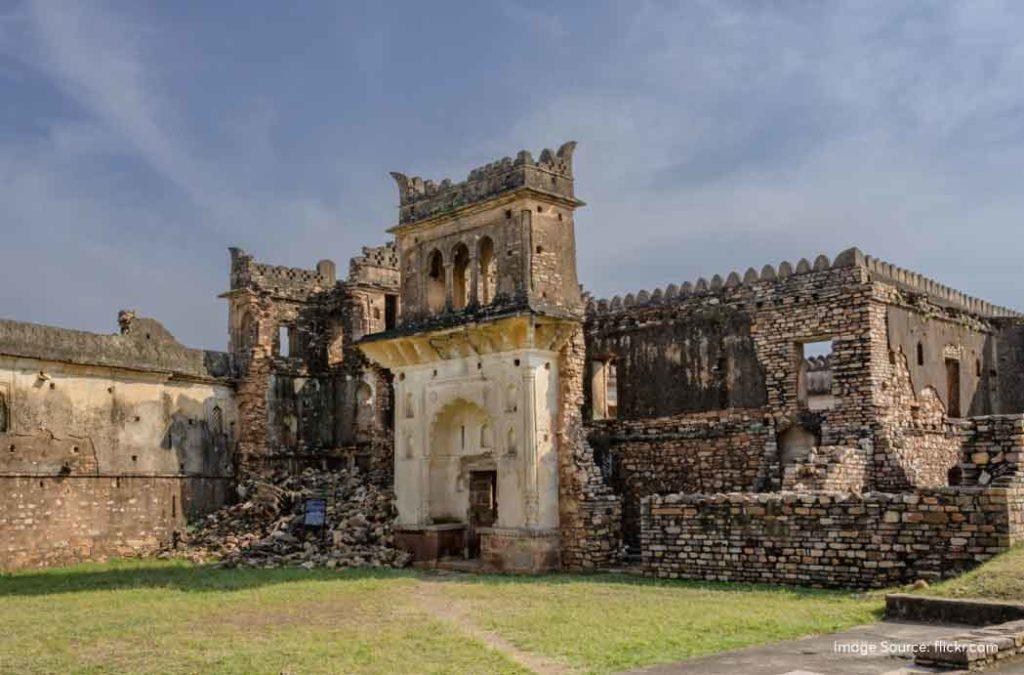
The Kalinjar Fort is one of those destinations that you can visit anytime during the year. It remains open all year round and tourists come here on all days. However, the season you want to visit depends on your personal preferences and the fort offers something exciting in every season.
Winter
The winter season starts in October and ends in March. This is a great time for sightseeing because the weather is pleasant with cool breeze blowing. It is the perfect time to explore the entire fort without getting tired and the surrounding forest is also at its full bloom. The temperature during the day can be anywhere between 10 to 25 degrees celsius. People of the region celebrate Mahashivratri with viguor in the month of February/March. Try to coincide your trip accordingly. This year in 2024, it falls on 8th March. The Neelkant and Chandidevi temples on the premises light up with celebrations during Mahashivratri.
Summer
The summer months are scorching hot in Kalinjar village with the morning temperatures going beyond 35 degrees Celsius. However, the greenery around the fort and the entire compound looks much brighter and glorious during these months. Tourists usually visit from April to June, seeing how it is an off-season and you can have the entire place for yourself. If you are planning to come here in the summer, do not forget to bring a bottle of water and rehydrating electrolyte drinks.
Monsoon
Monsoons are absolutely gorgeous at the Kalinjar Fort. The whole environment turns welcoming and the showers wash away the heat of the summer. You will also find the stepwells, kunds, and the holy Kalinjar pond filled with water. Devotees usually come here in the monsoon months to take a dip in the pond from July to September. The maximum temperature remains between 25 to 28 degrees Celsius. However, the village receives moderate to heavy rainfall during the peak monsoon months. You might find the roads to Kalinjar Fort slippery. Trekkers have to be very careful while climbing up.
How to Reach Kalinjar Fort?
By Air
The closest airport to Kalinjar Fort is at Khajuraho which is about 100 km away from the fort. However, only limited flights and private jets land on the runaway here. Alternatively, you can also choose to land at the Kanpur airport which is well connected with other metropolitan cities like Delhi, Mumbai, Jaipur, Ahmedabad, Hyderabad, Bangalore, and Chennai. Kalinjar Fort is about 175 km away from Kanpur airport.
You can reach Kanpur first, book your overnight stay at Hotels in Kanpur to rest, and head out toward Kalinjar Fort the next day. The 5-hour journey from Kanpur to the fort can be tiring so it is best to rest the day you land in Kanpur.
By Rail
The nearest railway station to Kalinjar Fort is in Atarra which is on the Banda-Satna rail route. Atarra is about 40 km away from the fort.
By Road
Chitrakoot, Banda, Allahabad, and Khajuraho have inter-city bus stations that are well connected with other metropolitan cities. Once you reach these regions, it is possible to find buses or private transport to Khalinjar Fort.
From the fury of the Gods to the stumped attempts of foreign invaders, Kalinjhar Fort has seen it all and still stands strong in the 21st Century. This marvellous tourist place lets you tap into history, discover new things, and also relax amidst the glory of nature. It offers breathtaking views of the surroundings and will take you down memory lane. Without any further delay, plan your trip to Khalinjar Fort and we are sure your vacation time will be very eventful!










